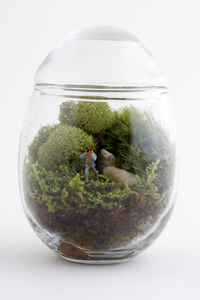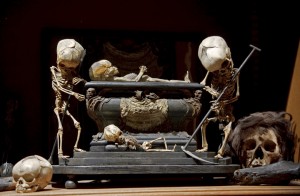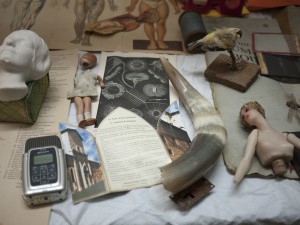 With Twig Terrariums
With Twig Terrariums
Date: Tuesday, May 22nd
Time: 7:30-9pm
Admission: $60 ***You must RSVP to phantasmaphile [at] gmail.com, as class size is limited. You will then be sent a Paypal payment request.
Presented by Phantasmaphile

|
|
|
Learn to create a Twig Terrarium with the Twig chicks, Michelle and Katy, of Brooklyn’s famed Gowanus neighborhood. They’ll provide hands-on guidance and offer tips and tricks to miniscape your own little green world out of moss. All the ingredients are provided, including little tiny people to populate your world! They’ll go over the steps to making a healthy terrarium, how to maintain it, and the different types of mosses we use.
Katy and Michelle are the creators behind Twig Terrariums. Their living sculptures have been featured in The New York Times, NPR’s Niche NYC Series, the Museum of Arts & Design, as well as the magazines Entrepreneur, Real Simple, Everyday with Rachael Ray, and Country Living. In Twig’s Brooklyn studio, they create moss terrariums and other small worlds to intrigue and delight. They use a variety of glass vessels, from antique and vintage to repurposed and recycled. Each terrarium comes complete with a tiny scene that ranges from naughty to nice and everything in between - Central Park muggings, crime scene investigations, fantasy lands full of fairies and unicorns, as well as the more bucolic scenes of waterfalls and hikers, forest scenes, and lovers in the park. Anything goes in a Twig Terrarium! Visit www.twigterrariums.com for more information on our very verdant venture.

Symbols reverberate with power. They are not just mere markings. Instead they convey and radiate magical forces. Because of this, symbols are among our oldest and most potent magical tools. Their use spans the globe, as well as a vast spectrum of spiritual and esoteric traditions. Magical symbols include seals and sigils- Kabbalistic and otherwise, Egyptian symbols, such as the ankh and the “girdle” of Isis, the Congo Cross, glyphs, runes, vèvè, alchemical, Masonic, fertility, Adinkra, and hex signs. Symbols serve virtually unlimited magical uses. They are incorporated into amulets, talismans, and mojo bags and used in divination, spirit summoning, and magic spells. The most accessible manner of working with symbols is candle magic. In this class, we will explore the esoteric power of symbols and how this power is transmitted through candles. The class will begin with a lecture about symbols and will then evolve into a hands-on workshop. Each attendee will have the opportunity to create a magic candle. Attendees will receive a hand-out of symbols. We will also discuss how to create your own magic symbols to serve your own personal needs and desires. PLEASE BRING a notebook or paper and something to write with, so that you can take notes. PLEASE ALSO BRING a candle. The size is up to you, but the larger and more substantial the candle, the more surface space is available for carving symbols into it. Birthday candles and tea lights are too small and tapers tend to break. Pillar and round votive candles are best. Colors, like symbols, radiate power and a candle’s color is chosen to coordinate with a spell-caster’s goal. Here is a list of traditional color associations, but if you possess your own associations, please trust your intuition: Black: protection; banishing; fertility; regeneration; healing chronic illness. Blue: protection; peace; healing emotional, mental or psychic illness; terminating addictions, including smoking. Brown: justice; legal issues; grounding. Green: fertility; prosperity; money; healing physical illness and conditions. Purple: power; sex; erotic love spells. Red: luck; good fortune; love; fertility; healing blood ailments. Pink: love; spells benefiting children. White: ancestral work; contacting those in the Next Realm. ***White candles possess the power of the blank slate and may be substituted for any other color. If in doubt or unsure, bring a white candle. Judika Illes is an independent scholar, international speaker, educator, and author of books of folklore, folkways, and mythology about the subjects of magic, the occult, divination, diverse spiritual traditions, witchcraft, and the paranormal. She is the author of four popular encyclopedias: The Encyclopedia of 5000 Spells, The Element Encyclopedia of Witchcraft, The Encyclopedia of Spirits, and the new Encyclopedia of Mystics, Saints, and Sages. Her other books include Pure Magic: A Complete Course in Spellcasting, Magic When You Need It and The Weiser Field Guide to Witches. Her website is: www.judikailles.com This event is in conjunction with Observatory’s Sigils & Signs group art show.  Fetal Skeleton Tableau, 17th Century, University Backroom, Paris; From The Secret Museum. © Joanna Ebenstein, 2010 A heavily illustrated lecture by Morbid Anatomy founder Joanna Ebenstein, followed by afterparty featuring thematic music and specialty cocktails by Friese Undine Since 2005, artist, independent scholar and Morbid Anatomist Joanna Ebenstein has travelled the world seeking out-and photographing whenever possible-the most fascinating, curious, and overlooked medical collections and wunderkammern, backstage and front, private and public. In the process, she has amassed not only an astounding collection of images but also a great deal of knowledge about the history and cultural context of these fascinating and uncanny artifacts. This Friday the Thirteenth, please join us for a heavily illustrated lecture based on this research, followed by a thematic afterparty. In her lecture “Anatomical Venuses, The Slashed Beauty, and Fetuses Dancing a Jig,” Ebenstein will lead you on a highly-illustrated tour of medical museums and introduce you to many of their most curious and enigmatic denizens, including the Anatomical Venus, the Slashed Beauty, the allegorical fetal skeleton tableau (as seen above), the flayed horseman of the apocalypse, and three fetuses dancing a jig. Ebenstein will contextualize these artifacts via a discussion of the history of medical museums and modeling, a survey of great artists of the genre, and an examination of other death-related arts and amusements which made up the cultural landscape at the time that these objects were originally created, collected, and exhibited. Following, please stick around for an afterparty featuring thematic tunes and inventive artisanal cocktails complements of the omni-talented Friese Undine. Joanna Ebenstein is a multi-disciplinary artist with an academic background in intellectual history. She runs the Morbid Anatomy blog and related open-to-the-public Brooklyn-based Morbid Anatomy Library. She is also the founding member of Observatory, a Brooklyn based arts and events space devoted to the revival of the 18th century notions of the dilettante and rational amusements. Her recent work—which includes photography, curation, installation, blogging, museum consulting, lecturing and writing—centers on anatomical museums and their artifacts, collectors and collecting, curiosities and marvels, 18th and 19th Century natural history and, as the subtitle of her blog states, “surveying the interstices of art and medicine, death and culture.” She has lectured at a variety of popular and academic venues, and her work has been shown and published internationally; she is the current Coney Island Musuem artist in resident, and recent solo exhibitions include The Secret Museum and Anatomical Theatre. You can find out more at her at her website astropop.com and her blog Morbid Anatomy; you can view much of her photography work by clicking here. She can be reached at morbidanatomy [at] gmail.com.  Post-deluge view of the Morbid Anatomy Library Collection Benefit Party to Rebuild The Morbid Anatomy Library On Good Friday, 2012, The Morbid Anatomy Library suffered a deluge; a fire in an upstairs gallery set off the sprinkler system, dousing the library below and destroying many books and artifacts. On Saturday, May 12th, come join Observatory and The Morbid Anatomy Library for a star-studded resurrection spectacular featuring Evan Michelson of TV’s “Oddities,” cult writer and luminary Mark Dery, our friends at The Midnight Archive, Absinthe compliments of Le Fée, music from The Thigh Highs, and artful gifts from Kikkerland. There will be also be a scintillating silent auction of taxidermy, artworks, specimens and ephemera, music from the Thigh Highs, and much, much more. Details to follow; for now please save the date, and stay tuned!
Sarah Baartman, the so-called Hottentot Venus, is one of the most tragic and often-cited figures in the history of the spectacle. In her 1996 play about Baartman, entitled Venus, Suzan-Lori Parks “finds poetry and comedy, as well as drama and meaning, in one of the most embarrassing episodes in our collective history: the life of the Venus Hottentot, a South African woman who, due in part to her enormous posterior, was exhibited in a cage throughout Europe and exploited professionally by the doctor who loved her.” Tony Kushner called Parks “one of the most important dramatists America has produced” and Coney Island USA is happy to be able to offer our visitors a reading of Venus, directed by Donya K. Washington in the Coney Island Museum.
‘With the center of the circle as a starting point, orientation can take on precise meaning in the context of its ritual, which was designed to secure spiritual knowledge and material dominion in the world through the agency of spirits, stars and cabalistic arcana.’ Magic Circles have been depicted in popular expressions of magic and witchcraft as well as detailed with full rubrics in traditional manuals of magic such as the Clavicula Solomonis or Liber Juratus. Using narrative, visual and textual material available from European grimoires and manuscripts, William Kiesel will discuss the various forms and functions of this important piece of apparatus employed by magicians in the Western Esoteric Tradition, including their role in providing authority and protection to the operator, as well as examples of their use in divination and treasure finding. WILLIAM KIESEL is an independent scholar researching occultism and western esotericism in practical and historical contexts. He is particularly interested in esoteric symbol systems and their use as manifested in alchemical, hermetic and occult traditions. In addition to giving presentations on these topics in the United States and abroad, Kiesel has also collaborated in avant garde music circles concerned with the esoteric use of music. It was the later context which led to his contribution in John Zorn’s acclaimed ARCANA series with an essay titled Musings on the Hermetic Lyre. His first book ‘Magic Circles in the Grimoire Tradition‘ is part of the Three Hands Press monograph series. William is the director of Ouroboros Press and editor at CLAVIS: Journal of Occult Arts. This event is in conjunction with Observatory’s Sigils & Signs group art show.  An early blood transfusion from lamb to man, ca 1705. From "Tryals Proposed by Mr. Boyle to Dr. Lower, to be Made by Him, for the Improvement of Transfusing Blood out of One Live Animal into Another," Mr. Boyle Illustrated lecture with Paul Craddock Those living in Britain (who owned a television set) about ten years ago might remember Sean Bean before he became a famous movie star. Apart from his appearance in Sharpe, he starred in a television advertisement for the National Blood Foundation, prompting people in his thick Yorkshire accent to ‘do something amazing today’; ’save a life’ by giving blood. The foundation’s message is still the same, though Sean Bean has moved onto other projects such as Lord of the Rings. In any case, this illustrated lecture is about just that: the transfusion of blood and its many meanings. But it focuses on a much earlier (and stranger) period of transfusion history when saving a life was only one reason to transfuse blood - from the sixteenth century to the nineteenth. The association between blood and life is a very easy one to make and seems to span all cultures and time periods, as does the very idea of swapping blood from one person to another. But what it means to swap one being’s blood with another’s - and why this might be attempted - has radically changed. It is only very recently, (around the turn of the twentieth century), that blood was transfused in order to purposefully replace lost blood. For the majority of this history, this was most certainly not the case. In the seventeenth century, transfusions of lamb’s blood were made to calm mad patients and, in the nineteenth century, blood was transfused in order to restore a portion of an invisible living principle living inside of it. This lecture explores from where these ideas came and the ways in which bits of them might linger in our own ideas of transfusion. On one last note: Paul Craddock commissioned a medical instrument maker to produce some early nineteenth century transfusion equipment. He hopes to demonstrate them at work if he can get them past customs! Paul Craddock is currently writing on pre-20th century transplant surgery and transfusion at the London Consortium working under Prof. Steven Connor (University of London) and Prof. Holly Tucker (Vanderbilt University, Nashville). After a brief time studying music and performing arts, living in rural China, and working for the National Health Service, Paul made the switch to cultural and medical history. He has never had a transplant and never received a transfusion - his interest in these procedures come from thinking about generally how we relate to the material world by making bodily transactions. He has lectured around the UK and Europe, and last year he spoke at the Observatory Gallery on skin grafting. Currently based in London, Paul is the Director of London Consortium Television, the audio-visual arm of the London Consortium (www.londonconsortium.tv). He is also the Guests’ Secretary for the University of London’s Extra Mural Literature Association. In another professional life, he produces films for medical establishments and museum exhibitions.
Philip Kadish is completing his PhD in American Literature at the City University of New York Graduate Center. He earned an MFA in fiction writing, and has written about the world of nineteenth century freak shows in fiction as well as scholarship. Full lineup and more information on The 2012 Congress of Curious Peoples can be found here.
Do you hunger to climb the corporate ladder with ruthless efficiency, leaving your rivals in the dust as you pursue your relentless quest for wealth and power? Hopefully not, but that doesn’t mean you can’t borrow some tactics from such people and apply them to your own ends; to that end, today’s class-taught by Oliver Burkeman, compulsive to-do-list-maker and journalist for London’s Guardian-will teach creatives, freelancers, and artists how to plan and manage multiple projects, better plan their time, and, in general, feel less overwhelmed by juggling a variety of projects at one time. Burkeman has spent much of the last few years researching and reporting on self-help culture, including the fascinating history of the “how to succeed” publishing genre, and motivational gurus from Dale Carnegie to Stephen Covey, and sifting the wheat from the chaff. (There’s a lot of chaff.) Drawing on this research, this workshop will explore some fundamental principles of getting organized, managing multiple projects, overcoming procrastination, time management, and being both more productive and less stressed in the kinds of sprawling artistic/creative/freelance lives that don’t get much attention in The Seven Habits of Highly Effective People. No cringe-inducing motivational speeches will be given; no Magic Systems for Instant Success will be promoted. Instead, we’ll plunder from the world of the grinning gurus the bits that actually work – so that you’ll leave equipped with a toolkit of immediately useable ways to do the stuff you’re already doing, and the projects you’re planning, with greater efficiency and ease. The class will begin with an illustrated lecture and conclude with a workshop segment where students will be guided in an application of the principles; participants are encouraged to come to class with a project to organize. Oliver Burkeman in a writer based in Brooklyn with an unhealthy interest in filing systems. He writes features and a weekly column on psychology for the (London) Guardian. His book The Antidote: Happiness for People Who Can’t Stand Positive Thinking will be published by Faber & Faber in the fall.
The Congress for Curious Peoples is a 2-day scholarly-yet-popular symposium that is part of the larger, 10-day Congress of Curious Peoples This year’s iteration will feature panel discussions on such topics as pre-cinematic immersive amusements and religion as spectacle, with featured speakers including Sara Velas of The Velaslavasay Panorama; Paul Koudounaris of Empire of Death; an as-of-yet unnamed representative of the amazing Sleep No More; and Colin Dickey, author of Cranioklepty. Also featured will be stand-alone lectures on the 17th century artist of fetal skeleton tableaux Frederik Ruysch and the phenomenon of ethnographic displays called “human zoos,” a screening of an over-the-top early 1970s TV Evangelist Christmas spectacular, and introductory lectures by myself and Coney Island Museum director Aaron Beebe. Full schedule follows; hope to see you there! SATURDAY APRIL 21st 11:00 – 12:00: Keynote Addresses
12:00 – 1:00: Lunch 1:00 – 3:30: Immersive Amusements: Cosmoramas, Cycloramas and Panoramic Illusions: Panel discussion moderated and introduced by Aaron Beebe, The Coney Island Museum
4:00 – 5:00: The Business of the Dead: Frederik Ruysch as an Entrepreneurial Anatomist, Lecture by Daniel Margocsy, Hunter College 5:00: Christmas in America: Miss Velma and the Evangelist Spectacle: Screening of “Christmas in America,” an early 1970s television special by Miss Velma, early TV evangelist, introduced by Daniel Paul SUNDAY APRIL 22 11:00 – 1:00: Religion and Spectacle: A panel with discussion moderated and introduced by Joanna Ebenstein, Morbid Anatomy Library
1:00 – 2:30: Lunch and Sideshow Visit 2:30 – 3:30: Traveling Ethnographic Shows and Human Zoos, a lecture by Elizabeth Bradley 3:30 – 5:30: Theater Rethunk: An Alternative History of the Theatrical: A panel with discussion moderated and introduced by Chris Muller
|
|
|